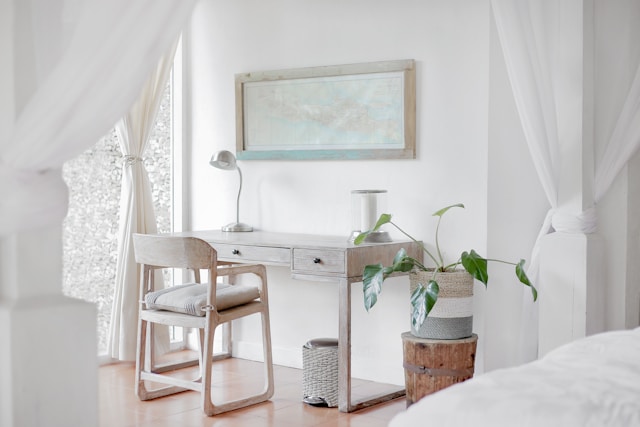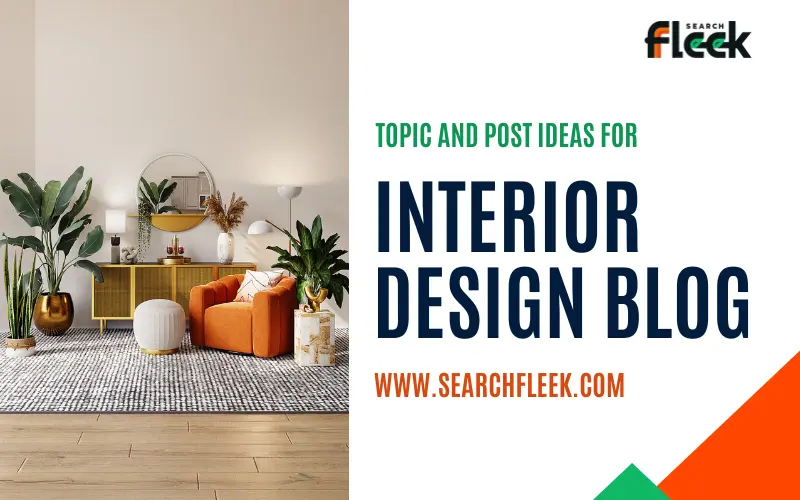Fueling your interior design blog with fresh content can feel like a constant challenge. Whether you’re a seasoned design professional or just starting your journey, keeping your audience engaged requires a steady stream of inspiring ideas. But fear not!
This list of 35 blog post ideas will spark your creativity and help you build a thriving online presence.
Interior Design Blog Topic Ideas
Design Inspiration & Trends
- Trending Color Palettes: Dive into the world of color trends! Analyze upcoming palettes and discuss how they can be incorporated into different interior styles.
- Spotlight on Sustainable Design: Explore the growing movement of sustainable design. Discuss eco-friendly materials, upcycling techniques, and energy-efficient practices.
- Global Design Influences: Take your readers on a journey around the world! Explore design trends from different cultures and showcase how they can inspire spaces.
- Luxury Design on a Budget: Create a post demonstrating how to achieve a luxurious aesthetic without breaking the bank. Offer tips on finding affordable alternatives and high-impact design tricks.
- Before & After Transformations: Showcase the power of interior design with incredible before-and-after transformations. Explain the design choices and highlight the dramatic improvements.
- Themed Room Ideas: Create a series exploring themed rooms for different purposes (e.g., home office, cozy reading nooks, luxurious bathrooms).
- Celebrity Home Style Decoded: Analyze the design choices of celebrities and dissect their signature styles.
Practical Design Tips & Advice
- Space Planning 101: Guide your readers through the basics of space planning. Offer tips for maximizing small spaces, creating traffic flow, and furniture placement strategies.
- Lighting Design for Every Room: Demystify lighting design! Explain different lighting types and how to use them to create specific atmospheres in various rooms.
- Choosing the Perfect Rug: Explore the world of rugs! Discuss different materials, sizes, and patterns and how to choose the right rug for each space.
- Window Treatment Options: Guide your readers through the various types of window treatments (drapes, blinds, shutters) and their advantages and disadvantages.
- Art Selection & Arrangement: Offer tips on selecting artwork for different spaces. Discuss how to choose the right size, style, and arrangement for a cohesive look.
- DIY Projects for Home Decor: Create a series featuring budget-friendly DIY projects for home decor. This could include wall art, throw pillows, or decorative accessories.
- Quick Fixes for Interior Design Dilemmas: Offer solutions for common design problems, such as awkward layouts, lack of storage, or poor lighting.
- Creating a Cohesive Color Scheme: Guide your readers through the process of creating a color scheme for their space. Discuss color theory basics and offer tips for choosing harmonious palettes.
Design for Specific Needs
- Designing for Small Spaces: Offer practical solutions and inspiring ideas for maximizing small apartments, studios, or compact rooms.
- Creating a Functional Home Office: Guide your readers through designing a functional and stylish home office. Discuss space planning, furniture choices, and storage solutions.
- Designing for Kids: Explore the world of kid-friendly design! Discuss safety considerations, age-appropriate furniture, and creative storage solutions.
- Accessible Design for All Needs: Highlight the importance of accessible design. Offer tips for creating spaces that are user-friendly for everyone, regardless of physical ability.
- Pet-Friendly Home Design: Cater to pet owners with tips on creating a comfortable and stylish home for both humans and furry companions.
Industry Insights & Business Growth
- The Power of Storytelling in Design: Discuss the importance of storytelling in interior design. Highlight how design choices can evoke emotions and create a sense of place.
- The Design Process from Start to Finish: Walk your readers through the design process for a project, from initial consultation to final installation.
- Client Communication Strategies: Offer tips on effectively communicating with clients and managing expectations throughout the design process.
- Building a Strong Design Portfolio: Share insights on creating a compelling design portfolio that showcases your expertise and attracts new clients.
- Marketing Strategies for Interior Designers: Discuss various marketing strategies for interior designers to reach their target audience, build brand awareness, and attract new business.
- Staying Current with Design Trends: Offer tips on how to stay informed about the latest design trends and resources to keep your skills and knowledge relevant.
Engaging Content formats
- Design Interviews with Industry Experts: Interview established interior designers, architects, or trendsetters in the industry.
- Design Q&A Sessions: Host a Q&A session where you answer reader questions about interior design challenges.
- Blog Tours & Collaborations: Collaborate with other interior design bloggers for blog tours or guest posts, expanding your reach to new audiences.
- Curated Design Resource Lists: Create curated lists of resources for your readers, such as online design stores, furniture brands, or inspiring design blogs.
- Design Challenges & Contests: Engage your audience by hosting design challenges or contests. Encourage readers to submit their own spaces or design ideas.
- Behind the Scenes Content: Offer a glimpse into your design process and daily life. This could include project sneak peeks, mood board inspiration, or design studio workspace tours.
Visual Inspiration & Social Media Strategies

- Virtual Room Tours: Give your readers a virtual tour of completed design projects. Showcase high-quality photos or even create 360-degree virtual tours.
- Inspiring Design Mood Boards: Create a series featuring mood boards for different design styles or room functions. Explain the design choices and offer tips on recreating the look.
- Instagrammable Interiors: Discuss the concept of “Instagrammable” design and how to create visually stunning spaces that are perfect for capturing social media moments.
FAQ: Interior Design Blog Post Ideas
How often should I post on my interior design blog?
Consistency is key! Aim for a regular posting schedule, whether it’s weekly, bi-weekly, or monthly.
What kind of visuals should I include in my blog posts?
High-quality visuals are crucial for engaging readers. Include high-resolution photos of completed projects, design inspiration sources, mood boards, and product recommendations.
How can I promote my blog and reach a wider audience?
Utilize social media platforms like Instagram, Pinterest, and Facebook to share your blog content and engage with potential clients. Utilize relevant hashtags and collaborate with other design influencers.
Conclusion
This list provides a springboard for your interior design blog. Remember, the best blog content is informative, engaging, and inspiring. Don’t be afraid to experiment, find your unique voice, and most importantly, have fun sharing your passion for design with the world!
We’d love to hear from you! What are some of your favorite interior design blog topics? Leave a comment below and share your ideas to spark further inspiration.
Emon Anam, CEO of Search Fleek, isn't your typical digital guru. He brings a unique blend of financial expertise (former banking pro!) and digital marketing mastery to the table. A self-proclaimed "SEO Sherlock Holmes," Emon unlocks content secrets for local businesses and SaaS companies. But beyond the keyboard, he's a devoted family man, music enthusiast, and cricket champion. Let Emon weave your digital success story!
AI Writing Disclaimer
This post was initially researched and outlined by me. The content was then generated by an AI language model using the provided information. The final text has been reviewed and edited by me for accuracy and clarity.





The article provides a variety of engaging blog post ideas for interior design enthusiasts. It covers topics such as DIY projects, design trends, organization tips, and room makeovers to inspire creativity. Additionally, it encourages incorporating personal stories and expert interviews to create compelling content that resonates with readers.